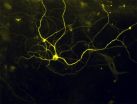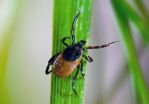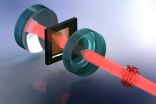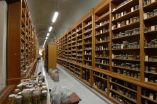(Press-News.org) CAMBRIDGE, MA -- Researchers have made great progress in recent years in the design and creation of biological circuits -- systems that, like electronic circuits, can take a number of different inputs and deliver a particular kind of output. But while individual components of such biological circuits can have precise and predictable responses, those outcomes become less predictable as more such elements are combined.
A team of researchers at MIT has now come up with a way of greatly reducing that unpredictability, introducing a device that could ultimately allow such circuits to behave nearly as predictably as their electronic counterparts. The findings are published this week in the journal Nature Biotechnology, in a paper by associate professor of mechanical engineering Domitilla Del Vecchio and professor of biological engineering Ron Weiss.
The lead author of the paper is Deepak Mishra, an MIT graduate student in biological engineering. Other authors include recent master's students Phillip Rivera in mechanical engineering and Allen Lin in electrical engineering and computer science.
There are many potential uses for such synthetic biological circuits, Del Vecchio and Weiss explain. "One specific one we're working on is biosensing -- cells that can detect specific molecules in the environment and produce a specific output in response," Del Vecchio says. One example: cells that could detect markers that indicate the presence of cancer cells, and then trigger the release of molecules targeted to kill those cells.
It is important for such circuits to be able to discriminate accurately between cancerous and noncancerous cells, so they don't unleash their killing power in the wrong places, Weiss says. To do that, robust information-processing circuits created from biological elements within a cell become "highly critical," Weiss says.
To date, that kind of robust predictability has not been feasible, in part because of feedback effects when multiple stages of biological circuitry are introduced. The problem arises because unlike in electronic circuits, where one component is physically connected to the next by wires that ensure information is always flowing in a particular direction, biological circuits are made up of components that are all floating around together in the complex fluid environment of a cell's interior.
Information flow is driven by the chemical interactions of the individual components, which ideally should affect only other specific components. But in practice, attempts to create such biological linkages have often produced results that differed from expectations.
"If you put the circuit together and you expect answer 'X,' and instead you get answer 'Y,' that could be highly problematical," Del Vecchio says.
The device the team produced to address that problem is called a load driver, and its effect is similar to that of load drivers used in electronic circuits: It provides a kind of buffer between the signal and the output, preventing the effects of the signaling from backing up through the system and causing delays in outputs.
While this is relatively early-stage research that could take years to reach commercial application, the concept could have a wide variety of applications, the researchers say. For example, it could lead to synthetic biological circuits that constantly measure glucose levels in the blood of diabetic patients, automatically triggering the release of insulin when it is needed.
The addition of this load driver to the arsenal of components available to those designing biological circuits, Del Vecchio says, "could escalate the complexity of circuits you could design," opening up new possible applications while ensuring that their operation is "robust and predictable."
INFORMATION:
The research was supported by an Eni-MIT Energy Research Fellowship, the National Science Foundation, the U.S. Army Research Office, the U.S. Air Force Office of Scientific Research, and the National Institutes of Health.
After more than six years of intensive effort, and repeated failures that made the quest at times seem futile, Harvard Stem Cell Institute (HSCI) researchers at Boston Children's Hospital (BCH) and Harvard's Department of Stem Cell and Regenerative Biology (HSCRB) have successfully converted mouse and human skin cells into pain sensing neurons that respond to a number of stimuli that cause acute and inflammatory pain.
This "disease in a dish" model of pain reception may advance the understanding of different types of pain, identify why individuals differ in their pain ...
Cloaking immune cells with antibodies that block T cell trafficking to the gut can substantially reduce the risk of viral transmission in a non-human primate model of HIV infection, scientists report.
The findings suggest that drugs that are already in clinical trials for inflammatory bowel diseases might be effective in the treatment or prevention of HIV infection.
The results are scheduled for publication in Nature Medicine.
"We were surprised by the effects that we observed," says senior author Aftab Ansari, PhD, professor of pathology and laboratory ...
It's a dog eat dog world, and bacteria have been living in it for a long time. It's of no surprise that bacteria have a sophisticated arsenal to compete with each other for valuable resources in the environment. In 2010, work led by University of Washington Department of Microbiology Associate Professor Joseph Mougous uncovered a weaponry system used in this warfare between bacteria. The combatants inject deadly toxins into rival cells.
Now, in a surprising twist, Mougous and colleagues have found that many animals have taken a page from the bacterial playbook. They steal ...
EAST LANSING, Mich. --- What will it take to convince skeptics of global warming that the phenomenon is real? Surely, many scientists believe, enough droughts, floods and heat waves will begin to change minds.
But a new study led by a Michigan State University scholar throws cold water on that theory.
Only 35 percent of U.S. citizens believe global warming was the main cause of the abnormally high temperatures during the winter of 2012, Aaron M. McCright and colleagues report in a paper published online today in the journal Nature Climate Change.
"Many people already ...
Physicists at the University of Basel have developed a new cooling technique for mechanical quantum systems. Using an ultracold atomic gas, the vibrations of a membrane were cooled down to less than 1 degree above absolute zero. This technique may enable novel studies of quantum physics and precision measurement devices, as the researchers report in the journal Nature Nanotechnology.
Ultracold atomic gases are among the coldest objects in existence. Laser beams can be used to trap atoms inside a vacuum chamber and slow down their motion to a crawl, reaching temperatures ...
Are Italian natural history museums (NHMs) on the verge of collapse? A new analysis published in the open access journal ZooKeys points out that these institutions are facing a critical situation due to progressive loss of scientific relevance, decreasing economic investments and scarcity of personnel.
The study proposes that existing museums associate and collaborate to form a diffused structure, able to better manage their scientific collections and share resources and personnel.
"Italy is universally known for its history, culture, food and art. The list of Italian ...
Scientists from Uppsala University, the Science for Life Laboratory (SciLifeLab) in Stockholm and Uppsala University Hospital have developed a new method of rapidly identifying which bacteria are causing an infection and determining whether they are resistant or sensitive to antibiotics. The findings are now being published in the Journal of Clinical Microbiology.
'Clinical use of the method would mean that the right antibiotic treatment could be started straightaway, reducing unnecessary use of antibiotics,' says Professor Dan I. Andersson of Uppsala University, who ...
HOUSTON - (Nov. 24, 2014) - New computer models that show how microtubules age are the first to match experimental results and help explain the dynamic processes behind an essential component of every living cell, according to Rice University scientists.
The results could help scientists fine-tune medications that manipulate microtubules to treat cancer and other diseases. Rice theoretical biophysicist Anatoly Kolomeisky and postdoctoral researcher Xin Li reported their results in the Journal of Physical Chemistry B.
Microtubules are cylinders made of 13 protein strands ...
People with moderate to severe obstructive sleep apnea may have an intrinsic inability to burn high amounts of oxygen during strenuous aerobic exercise, according to a new study led by researchers at University of California, San Diego School of Medicine.
The study, reported in the current issue of Journal of Clinical Sleep Medicine, shows that people with sleep apnea, in which breathing repeatedly starts and stops during slumber, have a lower peak oxygen uptake during aerobic activity than those who do not suffer from the sleep disorder.
People who suffer from apnea ...
From coral reefs to prairie grasslands, some of the world's most iconic habitats are susceptible to sudden collapse due to seemingly minor events. A classic example: the decimation of kelp forests when a decline of otter predation unleashes urchin population explosions. Three studies published in the Nov. 24 special issue of Philosophical Transactions of the Royal Society Biological Science hold the promise of helping resource managers predict, avoid, and reverse the tipping points that lead to degraded habitats, economic losses, and social upheaval.
The studies are the ...





